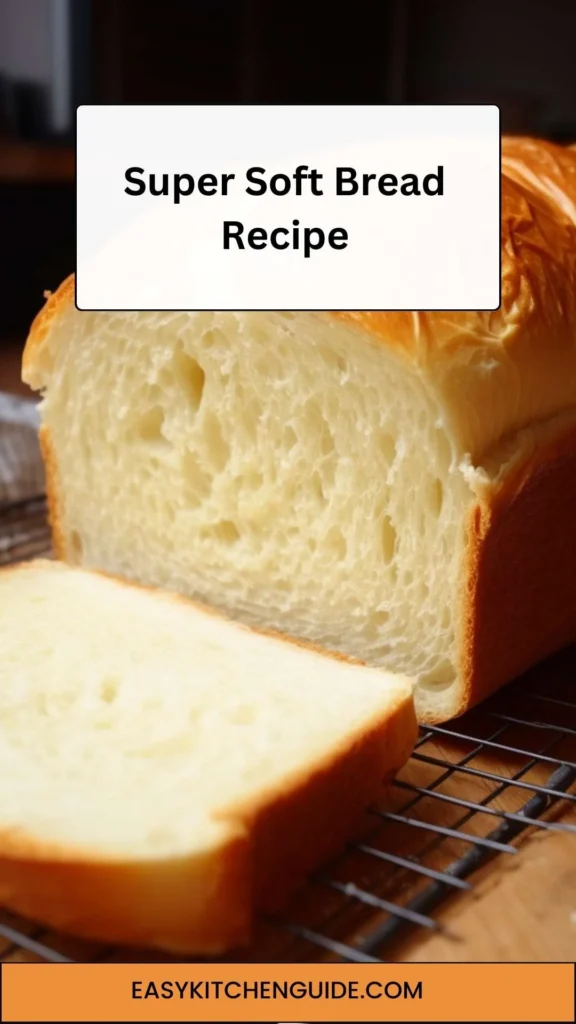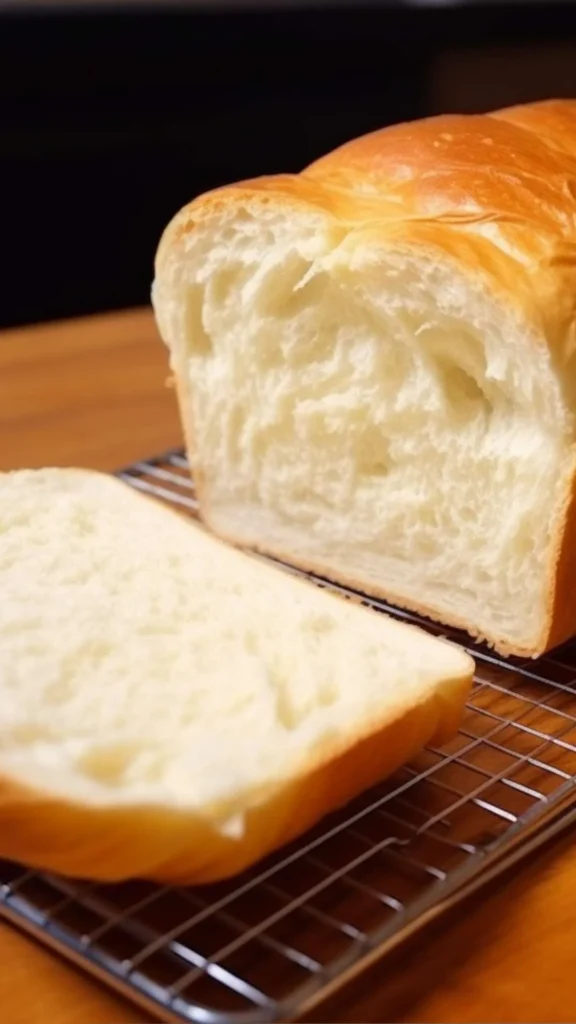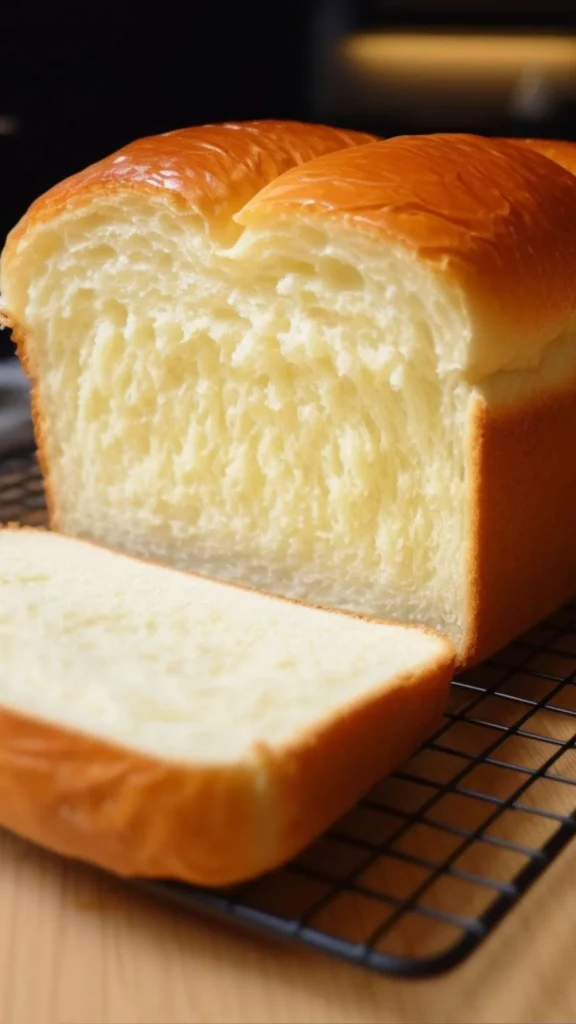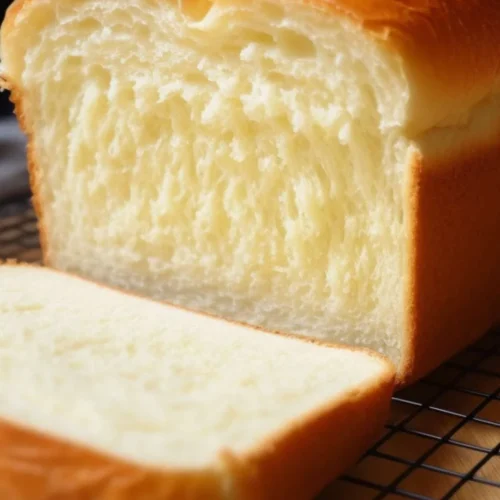Have you ever craved the perfect slice of bread—soft, fluffy, and downright irresistible? Look no further because I have the ultimate recipe for making super soft bread that will leave your taste buds dancing with delight.
I stumbled upon this recipe while experimenting in the kitchen, and it has since become a staple in my baking repertoire. Let me take you on a journey through the art of creating the softest, most delectable bread you’ve ever tasted.

You’ll also like the following Dinner recipes!
Ingredients:
- Low-fat warm milk: I used this ingredient because it adds moisture and richness to the bread dough, resulting in a softer and more tender texture. The warmth of the milk helps activate the yeast, allowing the dough to rise properly and develop its structure. Plus, using low-fat milk keeps the bread light while still providing a hint of creamy flavor, enhancing the overall taste and mouthfeel of the finished loaf.
- Unsalted butter, at room temperature: Butter enriches the dough, giving the bread a soft, pillowy texture and a rich, buttery flavor. It also helps to tenderize the crumb and prolong the bread’s freshness, ensuring it stays soft and delicious for longer. By using butter at room temperature, it integrates seamlessly into the dough, evenly distributing its flavor and moisture throughout.
- Egg: Adding an egg to the dough contributes to its softness and richness. The proteins and fats in the egg help to create a tender crumb and a golden crust, resulting in a loaf with a delicate texture and beautiful color. It also adds structure and richness to the bread, making each bite satisfying and flavorful.
- Sugar: Sugar not only sweetens the bread slightly but also provides food for the yeast, helping it to ferment and produce carbon dioxide gas, which leavens the dough and makes it rise. This fermentation process contributes to the softness and lightness of the bread, ensuring a fluffy texture and a pleasantly sweet flavor.
- Salt: Salt is essential for balancing the flavors in the bread dough. It enhances the overall taste of the loaf, bringing out the natural sweetness of the ingredients and adding depth to its flavor profile. Additionally, salt strengthens the gluten in the dough, improving its structure and contributing to a soft and chewy texture.
- Unbleached bread flour: I chose unbleached bread flour for its high protein content, which gives the bread structure and strength. The gluten formed during kneading helps trap the gas produced by the yeast, resulting in a light and airy crumb. Using bread flour also ensures that the bread has enough elasticity to rise properly and maintain its softness after baking.
- Water: Water is essential for hydrating the flour and activating the yeast in the dough. It helps form gluten, which gives the bread its structure and allows it to rise evenly. Using the right amount of water ensures that the dough has the perfect consistency for kneading and shaping, resulting in a soft and fluffy loaf.
- Active dry or instant yeast: Yeast is the key ingredient responsible for leavening the bread dough and giving it its soft and airy texture. Whether using active dry or instant yeast, it ferments the sugars in the dough, producing carbon dioxide gas that causes the dough to rise. This process creates pockets of air throughout the bread, resulting in a light and tender crumb that’s characteristic of super soft bread.

How to Make Super Soft Bread:
Step 1: Make the Tangzhong
Combine 3 tablespoons of bread flour and ½ cup of water in a small pot. Whisk the mixture until smooth.
Place the pot over medium-low heat and simmer, whisking frequently, until the mixture thickens into a thick paste. Once thickened, remove from heat and let it cool completely. This is your tangzhong mixture.
Step 2: Activate the Yeast
In a separate bowl, mix together ½ cup of warm low-fat milk, 3 tablespoons of sugar, and 1 ¼ teaspoons of active dry or instant yeast. Allow the mixture to sit for 5 minutes to activate and bloom.
Step 3: Prepare the Dough
In a large bowl, combine 2 ½ cups of unbleached bread flour, the yeast mixture, 1 egg, 1 teaspoon of salt, and the cooled tangzhong mixture. Mix until a sticky dough forms.
Cover the bowl with a damp towel and let the dough rest for 30 minutes to allow the gluten to develop.
Step 4: Knead the Dough
After resting, transfer the dough to a clean flat surface and knead it for 15-20 minutes, until it becomes smooth and stretchy.
Add 3 tablespoons of unsalted butter to the center of the dough. Fold the dough over the butter and continue kneading until the butter is fully incorporated and the dough is smooth again.
Step 5: Proof the Dough
Place the kneaded dough in a lightly greased bowl, cover it, and let it proof for 1 hour in a warm area until it doubles in size.
Step 6: Shape and Proof the Loaves
After proofing, remove the dough from the bowl and divide it into three equal pieces. Roll each piece into a long rectangle about 4 inches wide.
Starting from one short side, roll up the dough tightly towards the other side to form a log.
Place the rolled dough pieces side by side in a lightly greased 9×5 inch loaf pan, with the spiral sides facing out towards the long sides of the pan. Let the dough proof in the pan at room temperature for 40 minutes.
Step 7: Preheat and Bake
Preheat your oven to 350°F (175°C). In a small bowl, whisk together 1 egg and a splash of milk to create the egg wash.
After the 40 minutes of proofing, brush the egg wash over the top of the bread loaves.
Bake the bread in the preheated oven for 30-35 minutes, or until golden on top.
Step 8: Cool and Serve
Once baked, remove the bread from the oven and let it cool in the pan until it’s safe to handle. Then, transfer the bread to a wire rack to cool completely before slicing.
Enjoy your freshly baked super soft bread with your favorite spreads or as a delightful side to your meals!

Recipe Notes:
– Bread flour: Using bread flour gives the bread its characteristic chewiness and structure.
– Sugar: Adds sweetness and helps with browning.
– Salt: Enhances the flavor of the bread.
– Yeast: Essential for leavening the dough and creating air pockets.
– Milk: Adds richness and tenderness to the bread.
– Egg: Provides moisture and richness to the dough.
– Butter: Contributes to the softness and flavor of the bread.
Recipe Variations:
1. Honey Whole Wheat Bread: Substitute half of the bread flour with whole wheat flour and honey for a nutty, slightly sweet variation.
2. Cheesy Garlic Bread: Mix in grated cheese and garlic powder for a savory twist on the classic recipe.
3. Cinnamon Raisin Bread: Swirl cinnamon sugar and raisins into the dough for a decadent breakfast treat.

Super Soft Bread Recipe
Equipment
- baking dish
Ingredients
For the bread dough:
For Eggwash:
- 1 egg
- Splash of milk
Instructions
Step 1: Make The Tangzhong
- Combine 3 tablespoons of bread flour and ½ cup of water in a small pot. Whisk the mixture until smooth.
- Place the pot over medium-low heat and simmer, whisking frequently, until the mixture thickens into a thick paste. Once thickened, remove from heat and let it cool completely. This is your tangzhong mixture.
Step 2: Activate The Yeast
- In a separate bowl, mix together ½ cup of warm low-fat milk, 3 tablespoons of sugar, and 1 ¼ teaspoons of active dry or instant yeast. Allow the mixture to sit for 5 minutes to activate and bloom.
Step 3: Prepare The Dough
- In a large bowl, combine 2 ½ cups of unbleached bread flour, the yeast mixture, 1 egg, 1 teaspoon of salt, and the cooled tangzhong mixture. Mix until a sticky dough forms.
- Cover the bowl with a damp towel and let the dough rest for 30 minutes to allow the gluten to develop.
Step 4: Knead The Dough
- After resting, transfer the dough to a clean flat surface and knead it for 15-20 minutes, until it becomes smooth and stretchy.
- Add 3 tablespoons of unsalted butter to the center of the dough. Fold the dough over the butter and continue kneading until the butter is fully incorporated and the dough is smooth again.
Step 5: Proof The Dough
- Place the kneaded dough in a lightly greased bowl, cover it, and let it proof for 1 hour in a warm area until it doubles in size.
Step 6: Shape And Proof The Loaves
- After proofing, remove the dough from the bowl and divide it into three equal pieces. Roll each piece into a long rectangle about 4 inches wide.
- Starting from one short side, roll up the dough tightly towards the other side to form a log.
- Place the rolled dough pieces side by side in a lightly greased 9×5 inch loaf pan, with the spiral sides facing out towards the long sides of the pan. Let the dough proof in the pan at room temperature for 40 minutes.
Step 7: Preheat And Bake
- Preheat your oven to 350°F (175°C). In a small bowl, whisk together 1 egg and a splash of milk to create the egg wash.
- After the 40 minutes of proofing, brush the egg wash over the top of the bread loaves.
- Bake the bread in the preheated oven for 30-35 minutes, or until golden on top.
Step 8: Cool And Serve
- Once baked, remove the bread from the oven and let it cool in the pan until it’s safe to handle. Then, transfer the bread to a wire rack to cool completely before slicing.
- Enjoy your freshly baked super soft bread with your favorite spreads or as a delightful side to your meals!
Notes
- Bread flour: Using bread flour gives the bread its characteristic chewiness and structure.
- Sugar: Adds sweetness and helps with browning.
- Salt: Enhances the flavor of the bread.
- Yeast: Essential for leavening the dough and creating air pockets.
- Milk: Adds richness and tenderness to the bread.
- Egg: Provides moisture and richness to the dough.
- Butter: Contributes to the softness and flavor of the bread.
Frequently Asked Questions:
1. Can I use instant yeast instead of active dry yeast?
Yes, you can substitute instant yeast for active dry yeast, but you may need to adjust the rising time slightly.
2. Why do I need to let the dough rise twice?
Allowing the dough to rise twice improves the texture and flavor of the bread.
3. What is the purpose of the egg wash?
The egg wash provides a shiny, golden crust and helps toppings adhere to the bread.
4. Can I add nuts or seeds to the dough?
Absolutely! Feel free to add your favorite nuts or seeds for extra flavor and texture.
5. How long does the bread stay fresh?
Store the bread in an airtight container at room temperature for up to 3 days or freeze for longer shelf life.
6. Can I knead the dough by hand instead of using a mixer?
Yes, you can knead the dough by hand, but it may take longer to achieve the desired consistency.
Conclusion:
In conclusion, mastering the art of making super soft bread is a rewarding and fulfilling journey that will elevate your baking skills to new heights.
With the right ingredients, techniques, and a touch of creativity, you can create bread that is not only soft and fluffy but also bursting with flavor.
So roll up your sleeves, preheat your oven, and embark on a culinary adventure that promises to satisfy your cravings and impress your friends and family. Trust me, once you taste the magic of homemade super soft bread, there’s no turning back.
You’ll also like the latest recipes!
- Blueberry Peanut Butter Smoothie
- Brussel Sprout Quiche Copycat Recipe
- How to Make Goat Cheese Burger
My name is Lori Walker. I’m a registered dietitian, food blogger and food enthusiast. I share easy healthy, delicious recipes on my blog and review necessary kitchen items. The recipes I share take less… Read more

OMGEEE! This has to be the best ever white bread we’ve ever had! Beautiful, golden, softest, and fluffiest ever! The recipe is perfect… The egg and the Tangzhong method are key here! Do not cut corners! It won’t disappoint!
After making the tangzhong, could this be mixed and kneaded in s breadmachine??
do i have to use low fat milk
No, you can also use full fat milk. It will make the bread even richer and softer, adding a lovely depth to the flavor. It’s a great choice for this recipe—enjoy your baking! 🍞✨
I am a seasoned baker of about 60 year of baking bread. Today I tried your recipe and I can say without a doubt it is one of the best I have in my collection of breads Yes it is going in my collection. I did not change an ingredient but made it exactly as you described but in my bread maker, I just added the ingredients to the bread maker in the order you did in the recipe I did not bake in a loaf pan but did a three strand braid and baked in on my cookie sheet lined with a Silpat. So light and fluffy and a beautiful golden brown. Thank-you for this recipe!
thank you I wanted a recipe for my bread machine
Could you at least knead thru the first rise in s breadmachine??
Yes, you can definitely use a bread machine for the kneading process! 😊 Just place all the ingredients in the machine and set it to the dough cycle, which will handle both the kneading and the first rise. After that, you can shape the dough and let it rise again before baking. It’s a great shortcut while still getting that soft, fluffy texture! 🍞✨
I made 2 loaves of this bread last night so that we could enjoy one on Christmas Eve and one on Christmas Day. The bread was delicious, soft and fluffy! It was, also, quite easy to prepare. This bread will be enjoyed in our house very frequently! Thank you so much for sharing your fabulous recipe with us all! Merry Christmas and God bless you and yours!
What a wonderful Christmas treat! 🎄✨ I’m so glad the bread turned out soft, fluffy, and delicious—it sounds like it made your holiday extra special. Thank you for your kind words, and I’m thrilled the recipe will become a staple in your home. Wishing you and your family a Merry Christmas filled with love and blessings! 🍞❤️🎅
Can I use full fat milk
Absolutely! 😊 Using full-fat milk will make the bread even richer and softer, adding a lovely depth to the flavor. It’s a great choice for this recipe—enjoy your baking! 🍞✨
This recipe is superb! I made it using Oatmilk and plant based butter and it turned out fabulous! My family says it tastes like a dinner roll! So tasty and light and fluffy. I was afraid by “super soft”, it would be difficult to cut as it would crush down, but it doesn’t. The bread is super soft, but still firm enough to cut easily! I will be making this again! Thank you for the wonderful recipe!
I just noticed the Tangzhong recipe calls for 1/2 cup of Water, but the ingredient list says 3/4 cup of Water! What’s the extra 1/4 cup for??
I still don’t understand!! The ingredient list calls for 3/4 cup of Water. 1/2 cup of water is used for the Tangzhong, but the other 1/4 cup of Water isn’t accounted for. Is it a mistake or am I just not seeing where to add it? Anybody’s help would be appreciated!!
The flavor was good but I had a few issues I am hoping for feedback to improve my next try. First, the bread was more dense than fluffy. Did I need knead enough? Secondly, my logs did not form one cohesive log in the oven and when I cut the bread, it breaks off into 3 pieces.
Hello Lori, I have been making bread for some time and some very good ones, but this recipe top it all. This bread is delicious, soft and stay fresh for several days. my family loves it. This is my preferred bread. thank you for sharing this great recipe.